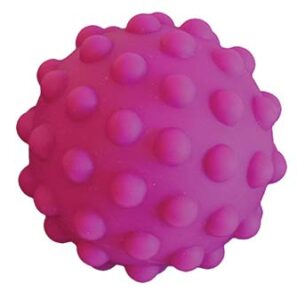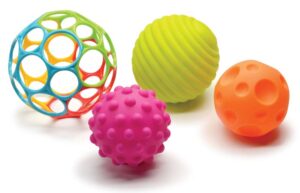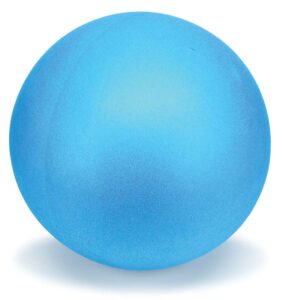Fine motor development
A young infant practices reaching for a ball.



 This brief activity is for a non-mobile infant. Place the infant on his/her back, and sit or kneel next to the infant’s feet. Hold the ball about eight inches from the infant’s chest. Talk with the infant as you slowly move the ball from side to side several times and then stop the ball at the midline. Lower the ball so the infant can touch it. Encourage the infant to touch or reach for the ball. Example: “Jacob, you see our ball. You are reaching your arms up to our pretty ball. I will move the ball so you can touch it.” Support the infant’s efforts to reach toward and touch the ball. If the infant grasps the ball, provide support for holding and feeling the ball. Avoid putting the ball in the infant’s hands. Smile and describe the infant’s actions. Conclude the activity when the infant loses interest.
This brief activity is for a non-mobile infant. Place the infant on his/her back, and sit or kneel next to the infant’s feet. Hold the ball about eight inches from the infant’s chest. Talk with the infant as you slowly move the ball from side to side several times and then stop the ball at the midline. Lower the ball so the infant can touch it. Encourage the infant to touch or reach for the ball. Example: “Jacob, you see our ball. You are reaching your arms up to our pretty ball. I will move the ball so you can touch it.” Support the infant’s efforts to reach toward and touch the ball. If the infant grasps the ball, provide support for holding and feeling the ball. Avoid putting the ball in the infant’s hands. Smile and describe the infant’s actions. Conclude the activity when the infant loses interest.
The activity is intended to foster coordination between seeing and reaching. In the opening segment of the activity, repeat slow movements of the ball from side to side if the infant shows signs he/she is enjoying looking at the ball, such as moving his/her head slightly as you move the ball to one side. Some infants may reach toward the ball with feet or hands. An infant may make swiping actions. An infant who rolls to his/her tummy may have the skills to raise head and torso and reach for the ball. If the infant moves to his/her tummy, place the ball in front of the infant for exploration. Keep the ball within the infant’s reach if the ball rolls when the infant touches it.
Extra support
Enrichment
Gross motor development
Infants with early mobility participate in a guided activity of getting a ball.



Be Prepared: This activity is for infants who can creep on their tummy or crawl on hands and knees, and have the emerging skill to grasp a small item, such as a ball. Clear the activity space of materials so there is plenty of room for infants to move around. Use balls made for infants.
[Sit on the floor close to several infants. Place the balls in front of you.]
Our balls can roll. Let’s get the balls and play!
[Invite infants by name to look at or move toward you and the balls. Example: (while holding up a ball) “Sonja, here is a bumpy ball.”
Gently roll balls toward specific infants. Push a ball with one finger. Example: “Our ball is rolling to you, Mateo.” Rolling a ball slowly helps an infant focus his/her vision on the ball as it moves closer.
Describe infants’ actions. Examples: “Lucy, you are sitting up with a ball that rolled close to you. You are tapping the ball with two hands!” “Yeah, Mateo! You crawled over to the ball. You pushed the ball with both hands. Oh, there it goes! It rolled to the chair.”
Give little cheers and clap your hands to recognize infants’ efforts. Use your voice to foster lively play.
Encourage individual infants to pursue their interests. Example: “All right, Christine! You turned around to go after a ball!”
Move closer to an infant who does not have a ball. Sit facing the infant and show him/her one ball. Ask “Are you ready?” When the infant reacts by looking, vocalizing, or gesturing, explain “I will roll a ball to you. Here it comes.” Move the ball gently so it stops in front of the infant.]
[Use a calmer voice to close the activity. Stay with infants on the floor to support those who are excited or tired from the activity. Hold an infant who needs extra support for getting calm, or move next to two infants to give them reassuring touches. Give each infant a gentle touch on his/her back.]

You might think of the activity as “open gym time” for infants! It is an opportunity for infants to explore and practice important motor coordination skills, including the anticipation of reaching out to touch a ball moving in the infant’s direction (motor planning).
Infants will participate in different ways: watching, holding a ball, reaching out to touch a ball, attempting to put a ball into his/her mouth, pushing a ball, following a ball by creeping or crawling. There will be differences in the use of one versus two hands. Some will focus on a ball, whereas others may be mostly interested in interaction with you.
Watch each infant’s involvement to ensure there is engagement in the activity. In addition to actions suggested in the activity plan, there may be opportunities for you to foster reaching skills by placing a ball close to an infant who has learned to creep with his/her tummy on the floor. The desire to get ahold of the ball may generate keen interest. Creeping on the tummy toward a ball is fun for some infants. A lightweight ball will roll easily when a creeping infant touches it.
If an infant creeps or crawls to a ball and touches it, the ball may roll out of reach. Describe the situation and encourage him/her to persist in getting the ball. Assist the infant in getting the ball before the infant becomes discouraged or distressed.
Games or rules for ball play are not appropriate for the age of infants involved in the current activity. In general, the ability to roll a ball back to an adult develops around an infant’s first birthday. Some infants may have the coordination to intentionally roll a ball by nine months.
Self-regulation skills are fostered in a lively play period with balls. Help infants who may get too excited during the play. Support for calming down may be needed at the conclusion of the play, as suggested in the activity description.
Extra support
Enrichment
Gross motor development
Older infants practice rolling a ball.



 This activity is for infants who can walk. Invite two infants to play a game of rolling a ball back and forth. Demonstrate how to roll a ball by pushing it with two hands. Emphasize a slow roll. Some infants will be most comfortable sitting down to roll a ball back and forth.
This activity is for infants who can walk. Invite two infants to play a game of rolling a ball back and forth. Demonstrate how to roll a ball by pushing it with two hands. Emphasize a slow roll. Some infants will be most comfortable sitting down to roll a ball back and forth.
There are several ways to arrange the activity. You may wish to support the two infants in rolling a ball between them. You may wish to roll a ball back and forth with each infant, one infant at a time, or be a third player in ball rolling.
Describe what is happening and help infants anticipate a ball coming their way. Examples: “Serena got the ball.” “Here is a ball rolling to you, Robert.” Positively recognize an infant’s effort and persistence. Encourage infants to push the ball with two hands, whether they are sitting or standing. Examples: “Use both hands. Push the ball.” “Great! You pushed the ball with both hands. It is rolling.”
Sometimes a ball may roll past an infant and stop out of reach. The unreachable ball is a problem for the infant to solve. Offer time and encouragement. Point to a ball if it seems the infant is not clear on its location. Describe infants’ actions. Examples: “You are watching our ball. You are pointing at the ball that rolled away. How can we get it?” “You are walking to the ball. You know how to get the ball!”
The activity involves many motor coordination skills plus the logistics of ensuring each infant has good opportunity to participate. Keep a close eye on each infant’s involvement so you can provide verbal guidance and hands-on help when needed. Helping an infant anticipate a ball coming his/her way is an important contribution. Be flexible about the activity so the infants’ needs, rather than a desire to keep the ball rolling, are your primary focus.
Extra support
Enrichment
Materials Needed: balls, unbreakable bowl, laundry basket
For young infants who are beginning to lift their heads or learning to roll over, arrange colorful balls on the floor where they can see them. Place small (3–4 inch) balls in a unbreakable bowl for creeping and crawling infants to discover. Provide lightweight balls for crawling and walking infants. Place a laundry basket next to a wall and encourage walking infants to drop balls into the basket.
Materials Needed: balls
Introduce balls to infants when toddlers and preschool-age children are not present. Older children will not readily understand the reason for not throwing a ball to or at an infant. It is a good idea to have one ball for each child when playing with balls. Toddlers and preschool-age children typically enjoy lively interactions with a caregiver while playing with one ball for every child and caregiver. Ball games with teams and rules are not suggested for preschool-age children. Encourage older children to practice existing skills, such as throwing, catching, and bouncing.